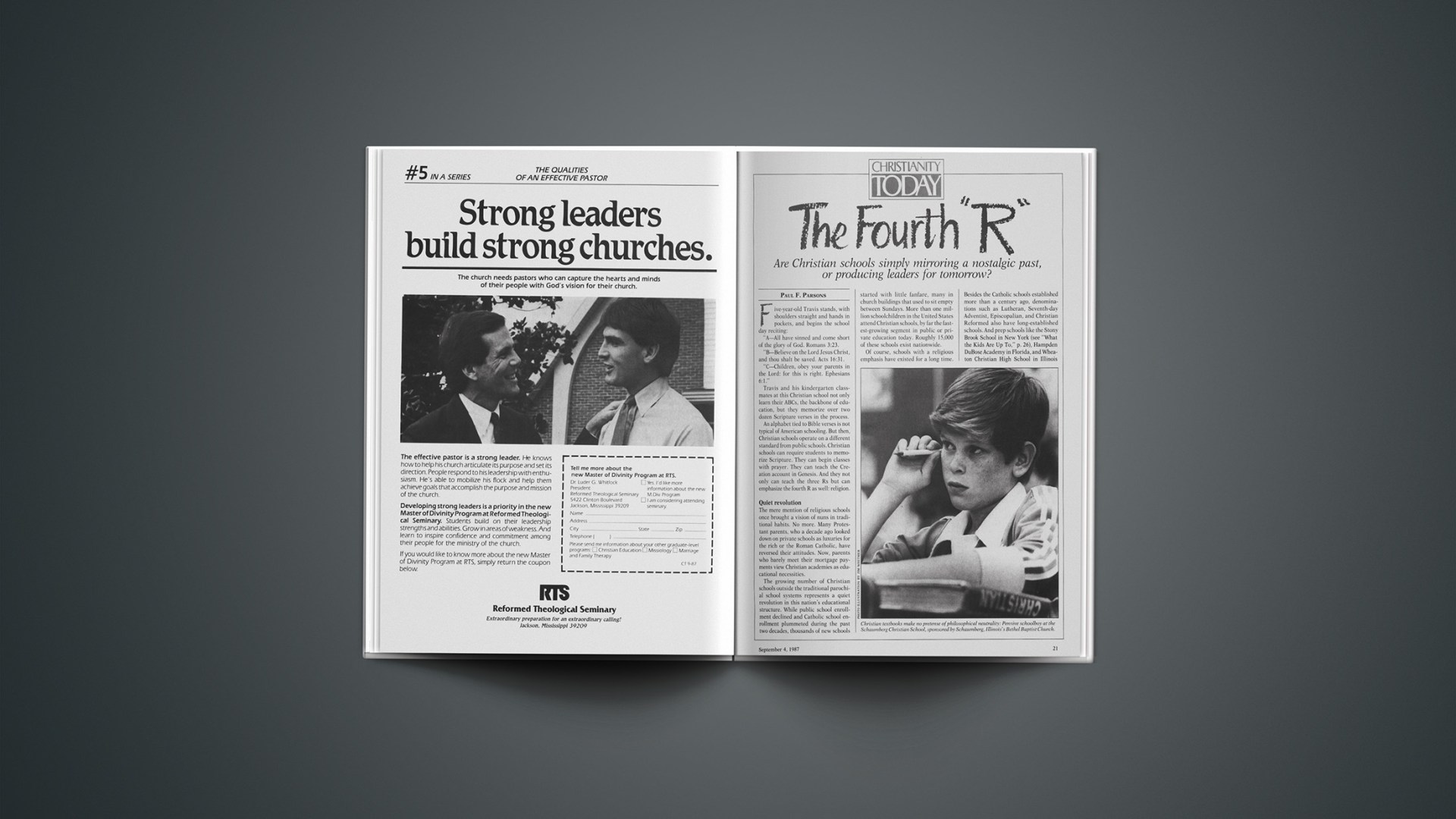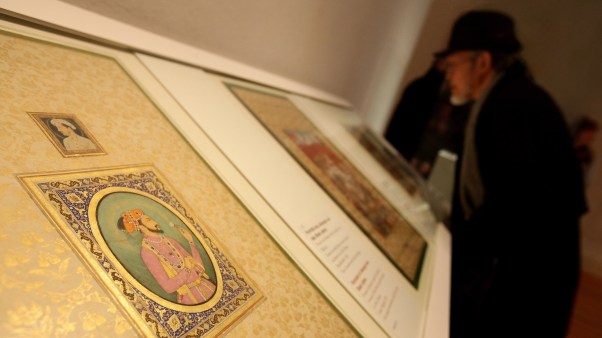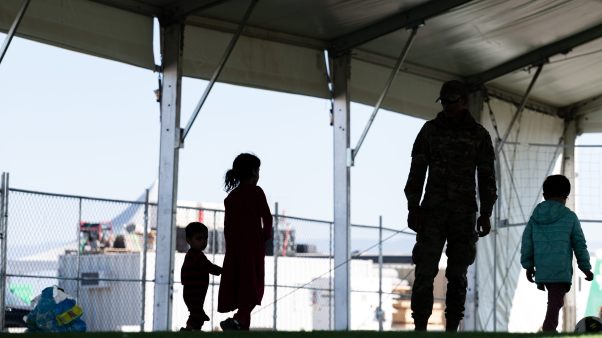Five-year-old Travis stands, with shoulders straight and hands in pockets, and begins the school day reciting:
“A—All have sinned and come short of the glory of God. Romans 3:23.
“B—Believe on the Lord Jesus Christ, and thou shalt be saved. Acts 16:31.
“C—Children, obey your parents in the Lord: for this is right. Ephesians 6:1.”
Travis and his kindergarten classmates at this Christian school not only learn their ABCs, the backbone of education, but they memorize over two dozen Scripture verses in the process.
An alphabet tied to Bible verses is not typical of American schooling. But then, Christian schools operate on a different standard from public schools. Christian schools can require students to memorize Scripture. They can begin classes with prayer. They can teach the Creation account in Genesis. And they not only can teach the three Rs but can emphasize the fourth R as well: religion.
Quiet Revolution
The mere mention of religious schools once brought a vision of nuns in traditional habits. No more. Many Protestant parents, who a decade ago looked down on private schools as luxuries for the rich or the Roman Catholic, have reversed their attitudes. Now, parents who barely meet their mortgage payments view Christian academies as educational necessities.
The growing number of Christian schools outside the traditional parochial school systems represents a quiet revolution in this nation’s educational structure. While public school enrollment declined and Catholic school enrollment plummeted during the past two decades, thousands of new schools started with little fanfare, many in church buildings that used to sit empty between Sundays. More than one million schoolchildren in the United States attend Christian schools, by far the fastest-growing segment in public or private education today. Roughly 15,000 of these schools exist nationwide.
Of course, schools with a religious emphasis have existed for a long time. Besides the Catholic schools established more than a century ago, denominations such as Lutheran, Seventh-day Adventist, Episcopalian, and Christian Reformed also have long-established schools. And prep schools like the Stony Brook School in New York (see “What the Kids Are Up To,” p. 26), Hampden DuBose Academy in Florida, and Wheaton Christian High School in Illinois have long served the evangelical community.
But these new schools established over the past 20 years that bear the name “Christian” are dramatically different. Largely independent, serving a local church and its communities rather than a denomination or national constituency, these schools were established in response to the secularist drift in public education. Many of them proudly call themselves “fundamentalist.” Others do not embrace the fundamentalist label (for instance, schools operated by charismatic churches), yet their theological orientation is similar. And still others that go by the name “Christian” are evangelical in nature but not at all fundamentalist in theological perspective.
But the new Christian schools are diverse in more than their theologies. Some are sprawling complexes with 2,000 students; others are one-room schoolhouses with a dozen or so pupils scattered across 12 grades. Some are elite academies with big tuition price tags; others keep the cost of education low by depending on volunteer mothers to help run the classrooms. Some are operated by parent groups that avoid doctrinal instruction; others are church-operated and specific in doctrine. But whatever their differences, the new Christian schools do have much in common.
Educating Souls
Religious instruction is a common denominator in America’s Christian schools. Walk into a first-grade class at Riverdale Baptist School in Maryland and you will hear the pupils reciting in unison from the Gospel of John. Sit in the twelfth-grade Bible class at Barrington Christian Academy in Rhode Island and you will gain an overview of religious cults in America. Visit the weekly chapel service at the Paw Creek Christian Academy in Charlotte, North Carolina, and you will hear the pastor’s dispensationalist view of the end of time. Step inside a history class at Christian High in El Cajon, California, and you will hear teenagers begin class with prayer for the President.
The intent of Christian schooling is not just to develop the minds, but to influence the very souls of its students. The Association of Christian Schools International (ACSI), an umbrella group representing 2,500 schools over a broad doctrinal spectrum, reported in 1986 that 30,000 of the 420,000 students at its member schools had been converted during the preceding academic year.
At many Christian schools academic subjects are bathed in Scripture. No dividing line exists between academics and religion because these schools consider the two inseparably linked. As one California principal puts it: “When we teach algebra, we don’t teach God all the time. But we do teach that God is a God of order. 2 + 2 = 4. That’s an absolute. Just as a number system has order, God has order. In history, we say nothing happens without God’s permission. History is dictated by God.”
Even the sports field is awash in religious significance. After every home game against a public school, players at a Christian academy in West Virginia hand out spiritual tracts to members of the opposing team. In Tennessee, a Christian school team prays with its opponent after every game. At Jerry Falwell’s Christian Academy in Lynchburg, Virginia, a school official said: “We tell our kids to play to represent the Lord. If you are losing your temper and complaining about the referees and then go after the game and try to witness to an opposing player, he’ll say, ‘Hey, what’s this?’ Sports is an opportunity to show our lifestyle.”
As the ACSI said in its newsletter: “Evangelism should be a normal part of the everyday curriculum in ‘God’s school system.’ ”
R-E-S-P-E-C-T
Another common denominator in Christian schools is a stress on discipline and traditional values. Hair and dress codes abound, paddlings are common, and respect for adults is shown through standard yes ma’ams and no sirs. At some schools, students must stand whenever an adult enters the room. For many parents, just as important as the four Rs is the belief that their children will graduate as responsible, well-behaved kids who can get good jobs or into good colleges. As a Christian school principal in Texas noted: “To be successful in college, advanced calculus isn’t as critical as teaching perseverance and reading skills and not doing drugs in order to finish your report on time.”
Of course, all schools public and private stress positive character traits. But Christian schools have more latitude in rewarding (or punishing) while seeking to develop such traits as these:
• Respect for authority. When an increasingly rebellious teenage girl talked disrespectfully to a teacher, the Christian school principal sent the girl to an isolation room. “We put her in the room by herself, gave her a Bible, and told her to read Proverbs,” the principal says. “She didn’t read any that morning because she was so mad. But before the day was over, she decided she’d rather read than just sit there. She read the Book of Proverbs and really broke. The Spirit of God really dealt with her that day.”
• Honesty. Student lockers don’t have locks at Pensacola Christian School in Florida. “Stealing is wrong. It’s a sin. God condemns it. We tell the student if he is caught stealing, he will be expelled,” a school official says.
• Punctuality. A teacher stands at the doorway holding a stopwatch, after ringing a bell to mark the end of recess at a Christian academy in Oklahoma. The students have 90 seconds to be inside and seated. “We teach them that time is important,” the teacher says.
• Character qualities. At the Southern Baptist Educational Complex in Memphis, “character quality report cards” are sent home to parents along with regular report cards. Pupils are evaluated in such areas as contentment, truthfulness, and humility.
Textbook Cases
In their drive for separation from all trappings of secular education, many fundamentalist schools, in particular, shun the state-adopted textbooks, using books published expressly for them. In these books, history is the tracing of the fingerprints of God through time. Science books attack evolution. Even math books have an evangelistic thrust: “Ace and his friend went soul-winning on five streets. There were nine houses on each street. To how many houses did they go?”
These books make no pretense of religious or philosophical neutrality. They are written from a fundamentalist perspective, with every subject bathed in scriptural interpretation and political conservatism. An American history textbook says of Franklin D. Roosevelt: “President Roosevelt himself lacked political convictions and principles.… The New Deal lengthened the Depression.” A science workbook bluntly says:
“Most ecologists do not believe in God as the Creator and Sustainer of the world.” Another textbook calls the United Nations “a clear illustration of man’s failure.”
There is even a Christian Student Dictionary on the market. “Some people wonder about the need for a Christian dictionary,” a representative of the publisher says. “But our current dictionaries are written by liberals. It shows up in word selections and in role reversals in the examples, like the woman going off to work and the man staying home with the children.”
Nonfundamentalist Christian schools do not necessarily subscribe to the political conservatism and theological orientation of the fundamentalist Christian textbook publishers, so these moderate Christian schools often use the same books found in public schools. But the vast majority of Christian schools carry their separation from public education that extra step, using only books wedded to their philosophy.
As One With Authority
Fundamentalist and nonfundamentalist schools differ most substantially in their emphases on authority. Nonfundamentalist Christian schools try to apply the doctrine of the priesthood of the believer to students. As the principal of a Christian school in Massachusetts says: “We major on the majors and don’t delve into doctrine. The end result, hopefully, will be the development of a thoughtful person who will be able to seek his own revelation from God.”
Fundamentalist schools, however, often emphasize the transfer of revelation rather than the pursuit of it. This is based on the belief that not only does an absolute Truth exist, but that every detail of lifestyle should reflect that Truth.
So fundamentalist schools authoritatively teach a lifestyle. Boys are taught to be the head of the household, and girls are taught to be helpmates. Some schools routinely pay male teachers more than their female counterparts by giving the men a head-of-household bonus. These schools may even regulate students’ out-of-school environment, prohibiting movie going, limiting dating, or mandating church attendance.
There is no undercurrent of tension at these schools. Students are uniformly accepting of the school’s norms. A boy may complain about having to get a haircut, or a girl may complain about having to wear a dress. But these are incidentals. When it comes to the spiritual atmosphere and the values taught amid academic lessons, the schools and students are in agreement.
The vast majority of students in Christian schools are there by choice. This is a byproduct of the enrollment process at these schools. Some churches operate schools only for the children of their own members. Others view Christian schools as evangelistic ministries, but interview students and parents beforehand to make sure each student has a willing attitude. Rebels are not invited.
The Christian school is frequently compared to a hothouse. “You have to realize the purpose of a hothouse,” says Paul Kienel, executive director of ACSI. “A hothouse is designed to protect young, tender plants during their growing years so they can be transplanted in the real world later on and be ahead of plants that didn’t have the opportunity.
“I grew up in Oregon,” Kienel continues, “and we had a hothouse nearby to grow tomatoes during the winter months. Outside the door were scrawny, gnarled plants that didn’t make it inside the hothouse. They were handicapped. Inside, the tomatoes were healthy and strong. The Christian school movement performs that function. It gets some basic character established before the child does battle with the world.”
A special bond exists between teachers and students in these schools. Teachers seem genuinely concerned about students’ academic progress and moral development. Teachers often view their work as a ministry instead of just a job. They get low salaries, but say they are compensated spiritually. An Iowa principal comments: “If I can train children to walk in the ways of the Lord, heaven is where I’ll get my big salary.”
And students appreciate the teachers’ sacrifices. They tell of teachers coming to their homes for free evening tutoring sessions. One student says: “I know the teachers aren’t here for the money. That makes me respect them even more.”
The Public-School Blues
To those within the Christian school movement, the roll call of public schools’ woes is as familiar as the ABCs. Besides standardized-test score declines and other external factors, those active in the movement are convinced that public schools do not teach values like they used to, do not discipline like they used to, and do not instill old-fashioned morality like they used to. The portrait they paint of public schools is unrelenting: chaos in the classroom, loss of authority, lack of learning, and an absence of standards.
“It’s ludicrous to think that our children are going to be change agents,” said Gerald Carlson of the American Association of Christian Schools, another umbrella organization that represents 1,200 fundamentalist, church-sponsored schools enrolling 170,000 students. “I think it’s an ignorance that people have of what the public schools have become. They are no longer these benign educational institutions. Public education has been in the hands of people who have sought to amend, and have been very effective in causing, social change in America.”
Christian-school advocates argue that public schools are as absolute in their teaching of relativism as Christian schools are absolute in their teaching of a singular Truth. Many Christians believe that, in the push to have a public school system free of religious entanglement, the nation has created, at best, a school system that has no values orientation and, at worst, one in which biblical values are scorned. The saying “Public schools teach how to make a living; we teach how to live” is often heard in Christian schools.
A “product” comparison with the public schools is difficult to make. Quantitative measurements routinely show Christian school pupils a grade level or two above national norms, and a number of Christian school graduates pursue higher education. But the comparison may be misleading because the public school is a melting pot, teaching all who come, while the Christian school is a selective hothouse.
White Fright?
This selectivity has led to a widespread perception that the new Christian schools are racist. After all, what once was a Southern phenomenon of the 1960s—segregationist academies quickly formed in the name of God—has spread nationwide. To some, “white-flight schools” and “Christian schools” are synonyms.
A secretary at a Christian school in North Carolina received a phone call from a woman, who asked in an urgent whisper, “Do you let them in?” The puzzled secretary responded, “Who do you mean, ma’am?” Caller: “The niggers, of course.” Secretary: “Why, ma’am, of course we do. We’re a Christian school.” The caller slammed the phone. At this particular school, one in eight students is black. In fact, many Christian schools now are integrated. But it is indicative of the public perception that a mother, in search of a place that does not allow blacks, would think of calling her local Christian school.
Still, Christian schooling is an overwhelmingly white phenomenon. Blacks are few and, like their white counterparts, may have been screened before admittance. But it is simplistic to conclude automatically that Christian schools are racially motivated. Christian schools reflect the structural segregation of parent churches, and the financial burdens of private schooling tend to be more difficult for minorities.
Christian-school educators also justify the low minority enrollment by pointing out that their schools appeal to a specific religious population just as Jewish schools serve a narrow Jewish population. Since schools are based on religious adherence, they contend they cannot recruit mathematical quotas of students equivalent to the larger community. Former Harvard researcher Peter Skerry wrote: “At least since the late 1960s, social and religious conservatism has been on the march. To reduce this conservatism and the Christian schools that have emerged from it to racism is simply to ignore two decades of social and cultural upheaval.”
Indisputably, racial prejudice served as a motive in the establishment of many “Christian” schools, especially in the South. But leaders of today’s Christian-school movement contend the true Christian schools have never been racist. Ronald E. Johnson, vice-president of Accelerated Christian Education Inc., says: “In the Deep South in the ’60s, there was a racist movement among private schools, and many called themselves Christian schools. They took on a Christian name, but they were not Christian schools in the sense that they deliberately taught Christian principles, ethics, and Scripture. The Christian-school movement today has them memorizing Scripture and reading from Christian textbooks. It’s a total church immersion. There’s a big difference between what those old white-flight schools were in the Deep South and what Christian schools are today.”
No More Pluralism
Besides the race issue, Christian schools have gained public attention through clashes with state agencies over school licensing and teacher certification. In 1982, a judge ordered the padlocking of Faith Baptist Church in Louisville, Nebraska, because it was operating a school in defiance of a law requiring all schools to be state-licensed and all teachers to be state-certified. The church contended that education is the prerogative of the parents, not the state, and that licensing the school would be akin to licensing the church itself. The church lost in court, but eventually won a legislative victory that freed religious schools from state regulation.
The new Christian schools as a whole represent a vehement rejection of state-sponsored education. The intent of Christian schooling is separation, not the melting-pot pluralism of years gone by. That is because the meaning of pluralism has undergone a radical redefinition in the past two decades.
In earlier years, pluralism meant merging various nationalities, religions, and languages into one “American way.” Those who did not acculturate were left out. Our public schools were designed to fulfill this historic acculturation process. We standardized the education process to “Americanize” the nation. Since society was then dominated by Protestant values and concepts, this acculturation process was firmly rooted in cultural Protestantism. Jews and Catholics were tolerated as components in the country’s notion of religious freedom. In this form of religious pluralism, differences were discussed within the context of the reigning Protestant culture.
Today, pluralism means the right to be American without acculturation. Frankly, no one expected cultural Protestantism ever to be challenged as the symbolic model of America. But the redefinition of pluralism after World War II changed all of this. The prevailing hegemony came unglued, and there was suddenly no longer one dominant set of cultural values. Church attendance dropped precipitously. By 1960, Americans no longer had to have a Protestant president. The Supreme Court refused to let the public schools continue two of the outward symbols of cultural Protestantism—prayer and Bible reading. Quite suddenly, Protestantism no longer served as this nation’s undisputed defining authority.
In turn, the educational establishment responded by formulating “value-free” education, another name for secularism. Instead of espousing particular values, the public schools espoused the value of the search for values. Maybe that was all they could do legitimately. But this transformation to a secular educational system led those still adhering to the values of cultural Protestantism to rebel. Many Christians chose to build an alternative community rather than acculturate to a society they believed had gone bad.
A Refuge For Dissent
Similarities exist in the creation of the Catholic schools a century ago and the rise of the new Protestant schools. In both instances, private schooling served as a refuge for dissenters from the value system explicitly or implicitly adopted by the public schools. As Patricia Lines, former director of the Law and Education Center for the Education Commission of the States, wrote: “When public school values were Protestant, a vigorous Roman Catholic school system emerged. Now that public school values are secular, a strong Protestant private school movement has emerged. In fact, taking the sharp decline of Catholic school enrollment under consideration, it may be that many Catholics now regard the public schools as safe for their children, while an increasing number of Protestants do not.”
In part, the move to establish new Christian schools embodies a nostalgia for the security of the past. It yearns for a return to “old-time religion” and “old-fashioned virtues.” It looks back wistfully to a golden era, a simpler time. Those in the forefront of Christian schooling idealize the public schools of yesteryear for stressing the three Rs, for having textbooks portraying the traditional family, for paddling children who disobeyed, for serving their own homogeneous communities, and for beginning the school day with a Bible verse and prayer. Many of today’s Christian school educators want to mirror the public schools as they remember them from their day. Others have gone even further back, to the era of the one-room schoolhouse and to workbooks that resemble the moralizing McGuffey Readers of a century ago.
In 1987, Christian school educators forge ahead in their mission to provide a by-the-Book education to a growing body of the nation’s youth. Just as important as reading and riting is the teaching of right and rong. “I want to produce young people who can stand up to their peers and say, ‘No, that’s not right,’ without being obnoxious,” one Christian-school teacher said. “If we can make Christian schools strong enough academically but not too narrow, it may very well produce the leaven to reproduce Christian values in our society.”
Paul F. Parsons is R. M. Seaton Associate Professor of Journalism, Kansas State University. In 1983 he received a religious studies fellowship from the University of North Carolina, which allowed him to visit about 100 Christian schools in 60 cities. His book on Christian schools will be released by Mercer University Press early in the spring of 1988.
Ace Virtueson Meets Pastor Alltruth
The classroom is quiet. No teacher’s voice booms out an explanation of nouns and verbs. No teacher’s chalk scratches the blackboard during a multiplication exercise. No teacher’s ruler touches a map in a discussion on European alliances during World War II. In fact, there are no teachers at all in this school.
This is an Accelerated Christian Education (ACE) school—one of 4,800 “teacherless” schools educating about half a million children nationwide. Roughly a third of all Christian schools in the United States operate with the ACE curriculum.
These schools operate the same, be they in Alabama or Arizona, Ohio or Oregon. They use the same books, have the same operational procedures, and are run by male supervisors who undergo identical training at ACE headquarters in Lewisville, Texas. The supervisor, almost never state-certified, may be the only paid employee in the school; he is typically assisted by volunteer mothers.
Students in individual cubicles work silently at their own pace, mastering workbooks that stitch Bible verses into lessons on, for example, nouns and verbs, multiplication problems, and European history. The adults are present to motivate, discipline, and answer questions. But the teaching comes from a series of workbooks—disposable paperbacks, roughly 40 pages each—that contain topical essays interspersed with multiple-choice, fill-in-the-blank, and other questions.
A pupil goes through about 60 workbooks a year in math, science, English, social studies, and word building. On the secondary level, a Bible course and a variety of electives are offered. The workbooks carry colorful cartoons featuring clean-cut, happy children with such names as Ace Virtueson, Christi Lovejoy, and Reginald Upright. Ace, Christi, and friends mature into responsible, soul-winning teenagers in the advanced workbooks. The adult role models in the workbooks go by the names of Pastor Alltruth, Mr. Friendson, and Miss Content.
The day at an ACE school starts with an assembly, featuring singing, pledges of allegiance, Scripture memorization, and a motivational word from those in charge. The morning is devoted to exclusively academic pursuits. Students spend about one hour at a time in the workbooks. They have breaks ranging from five minutes on up, depending on whether the student met previous work goals.
The afternoons at an ACE school are devoted to more workbook exercises, along with activities and devotionals. Wednesdays are special chapel days that feature an hour-long religious service, no workbooks, and an early dismissal. Fridays often include a field trip.
The ACE program is credited with much of the boom in fundamentalist Christian schooling. Dr. Donald R. Howard started ACE in 1970 to provide parents an inexpensive alternative to public education. For $5,000 or less, ACE can transform any pastor into the principal of his own Christian school in a matter of weeks. ACE supplies the workbooks and tests and, for additional costs, even red-white-and-blue uniforms for children.
The central tenet of ACE is the belief that teaching is not important in the learning process, ACE believes children learn more effectively by working out of a book at their own pace than by listening to a teacher who, by necessity, must keep the class at a common plateau.
“It’s a false premise that, because a body with a degree stands in front of a room and speaks words, learning is taking place,” said ACE vice-president Ronald E. Johnson, who is himself a former public-school principal in Arizona. “It’s a false assumption to believe that every child in that room is at the same level of understanding,” he said. “There is no classroom of 25 children in which they are all at the same academic or maturity level.”
Thus graduation from ACE schools is based solely on workbook progression, not chronological age.
By Paul F. Parsons.
What Living Word School Doesn’t Have
The school day at Living Word Christian School in Manhattan, Kansas, does not begin with math or phonics or social studies. It begins with prayer and Bible verses. Teachers report to work an hour early for a collective prayer time. When school starts, pupils begin the day with sentence prayers of their own.
Classrooms have a familiar look, with pupils at their desks and teachers at the blackboard. Using the A Beka Book curriculum designed for Christian schools, teachers rely on the lecture method. In a junior-high classroom, the lesson centers on dependent and independent clauses. “Just as you are dependent on your parents, the dependent clause in a sentence is dependent on the subordinating conjunction,” the teacher tells the teenagers. It is a basic grammar lesson, but the example reinforces the parents’ role.
Third and fourth graders have a science lesson on skin. They talk about cuts, and the teacher says, “God made your body where it can heal.” They talk about nerve endings in fingers, and the teacher says, “God put inside of you something called a reflex. Your body will move away from pain.” They make their fingerprints with an ink pad. “No one has a pattern like anybody else,” the teacher says. “God has made every person unique.” The academic lesson deals with the properties of skin. But the word God is part of the conversation throughout. A merger has occurred between the educational and the religious. This is common, and desired, in Christian schools.
Living Word Christian School is part of a rapidly growing charismatic church started in 1981 through home Bible studies. Church membership mushroomed from 50 to 275 in three years, and the church and school now occupy a former roller-skating rink. The school started in 1984 with 28 students. It has grown to 50 pupils in grades K-10. The school is adding one grade each year until it is a 12-grade school.
As a charismatic body, Living Word emphasizes healing powers. A boy comes to a teacher’s desk and says a tooth hurts. The teacher is sympathetic and asks the boy if his tooth has to hurt. The boy says no. “Can God get rid of the pain?” the teacher asks. The boy says yes and closes his eyes while standing next to the teacher’s desk and prays: “Please help my tooth to not hurt and help it to feel better.” The teacher says amen, and the boy returns to his chair. School principal Cecilia Myers says the boy would be encouraged to see a dentist if the tooth continued to hurt. “We believe God can heal, either through doctors or through prayer,” she says.
All but one of the school’s five full-time teachers are state-certified, and several are former public-school teachers. Beth Uphoff is one of them: “I had such a negative attitude toward Christian schools. It was an escapist trend. I thought that kids wouldn’t be able to deal with reality once they got out of the hothouse. I felt like I should be in the public schools, witnessing to them there. But the Lord changed my heart. I saw a vision for Christian education.”
Because the school is small, it lacks a lot of standard features. The children bring sack lunches each day, and recess is held on the church’s asphalt parking lot. Talking to a group of parents, Pastor Gary Ward, a former public-school biology teacher, says: “There’s a lot we don’t have. We don’t have a football team. We don’t have a marching band. We don’t have enough typewriters. We don’t have a lunchroom.”
Then, without breaking stride, Pastor Ward shifts the emphasis. “We don’t have a drug problem. We don’t have an alcohol problem, or classes that teach about contraceptives. We don’t have a lot of things.”
The school also doesn’t have tuition. It requires a tax-deductible “donation” to the church of roughly $80 a month per child. “This isn’t a private school operated as a business on the side,” Ward says. “It’s a ministry of the church.”
By Paul F. Parsons.










